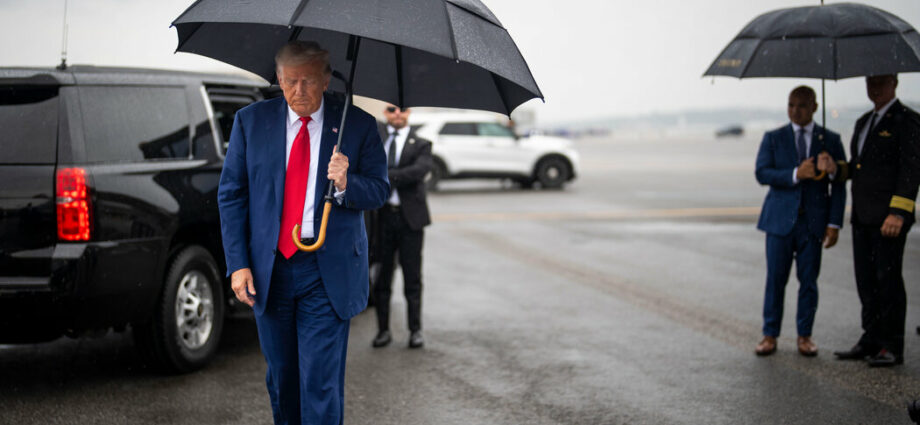Former President Donald J. Trump returned to Washington on Thursday, rose to full height, lifted his right hand and swore an oath. This time it was not to assume power, but to promise that he would abide by a bond agreement that would allow him to leave the federal courthouse without paying bail or agreeing to any travel restrictions.
Mr. Trump’s second federal arraignment seemed on the face of it to be more routine than the first one: last month in Miami after he was indicted on charges of mishandling classified national security documents and obstructing the government’s efforts to reclaim them.
He seemed a bit more at ease. And so did the man who has led the investigation that resulted in his indictments, Jack Smith, the normally stony-faced special counsel, who allowed himself a few smiles as he shook hands with F.B.I. agents when the half-hour hearing ended.
But if his second federal arraignment was less novel in a been-there-done-that way, the gravity of the four charges the government has leveled against him gave the proceedings a sense of historical weight not present in the Florida case.
As if to underscore that point, at least three of the district court judges who have presided over trials of the Trump supporters charged for their roles in the assault on the Capitol on Jan. 6, 2021, filed into the back row of the visitors gallery to observe. One of them was Judge Amy Berman Jackson, who called out Mr. Trump’s “irresponsible and knowingly false claims that the election was stolen” in imposing a harsh sentence on a rioter who bludgeoned a Capitol Police officer into unconsciousness.
But all eyes in the courtroom were, once again, on the second face-to-face encounter between the former president and Mr. Smith, who has filed charges that could put the 77-year-old Mr. Trump in a federal prison for the rest of his life. This time, unlike in Miami, the two men were positioned in a way that they could be visible to each other.
Mr. Smith entered the courtroom — normally used by the district’s chief judge, James E. Boasberg — about 15 minutes before the scheduled 4 p.m. start, with his lead prosecutor in the case, Thomas P. Windom, and positioned himself in a chair behind his team, with his back against the rail dividing participants from the gallery.
Mr. Trump walked in very slowly — in his signature long red tie and long blue suit coat — surveying the room and mouthing a greeting to no one in particular. His in-court retinue included M. Evan Corcoran, a lawyer for Mr. Trump who is a witness in the documents case, and one non-lawyer, his spokesman, Steven Cheung.
Mr. Trump glanced briefly in Mr. Smith’s direction, but he did not seem to make eye contact.
That was a strikingly different approach than he has taken outside the courtroom, where he has called Mr. Smith “deranged” and promised to fire him if he is re-elected.
Mr. Trump spoke in respectful tones when questioned by Moxila A. Upadhyaya, the magistrate judge who presided over the proceeding.
Yet if he seemed chastened and ill-at-ease in Florida, he was more animated in his return to Washington, with flashes of his usual, freewheeling conversational style.
When she asked his name, he replied, “Donald J. Trump” — then added “John!”
When she asked his age, he raised his voice a notch and intoned, “seven-seven!”
At the end of the proceeding, Judge Upadhyaya thanked Mr. Trump, who said, “Thank you, your honor.” On the “all rise” command, he stood up. One of his lawyers put his arm on Mr. Trump’s back and guided him away from the table and out the courtroom door.
Glenn Thrush covers the Department of Justice. He joined The Times in 2017 after working for Politico, Newsday, Bloomberg News, The New York Daily News, The Birmingham Post-Herald and City Limits. More about Glenn Thrush
Source: Read Full Article
-
Major boost for pensions as Jeremy Hunt poised to raise cap tomorrow
-
Suella Braverman goes head to head with Elton John over heated ‘gay’ migrant row
-
Trump Seeks U.A.W.’s Support as the Union Wavers on Backing Biden
-
Trump Faces Major New Charges in Documents Case
-
Leader of International Seabed Mining Agency Admonished by Diplomats

